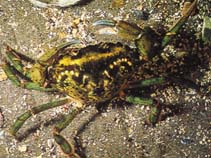Advertisement
Carcinus maenas (Linnaeus, 1758)
Green crab| Native range | All suitable habitat | Point map | Year 2050 |

|
| This map was computer-generated and has not yet been reviewed. |
| Carcinus maenas AquaMaps Data sources: GBIF OBIS |
France country information
Common names:
[No common name]
Occurrence: native
Salinity: marine
Abundance: | Ref:
Importance: | Ref:
Aquaculture: | Ref:
Regulations: | Ref:
Uses: no uses
Comments: Known from Roscoff (Ref. 114110). C: Ref. 114110.
National Checklist:
Country Information: https://www.cia.gov/library/publications/resources/the-world-factbook/geos/fr.html
National Fisheries Authority:
Occurrences: Occurrences Point map
Main Ref: Roman, J.O.E. and S.R. Palumbi, 2004
National Database:
Occurrence: native
Salinity: marine
Abundance: | Ref:
Importance: | Ref:
Aquaculture: | Ref:
Regulations: | Ref:
Uses: no uses
Comments: Known from Roscoff (Ref. 114110). C: Ref. 114110.
National Checklist:
Country Information: https://www.cia.gov/library/publications/resources/the-world-factbook/geos/fr.html
National Fisheries Authority:
Occurrences: Occurrences Point map
Main Ref: Roman, J.O.E. and S.R. Palumbi, 2004
National Database:
Common names from other countries
Classification / Names Κοινά ονόματα | Συνώνυμα | Catalog of Fishes (gen., sp.) | ITIS | CoL | WoRMS
Environment: milieu / climate zone / depth range / distribution range Οικολογία
; Υφάλμυρο; εύρος βάθους 0 - 200 m (Αναφ. 2779), usually 0 - 6 m (Αναφ. 114208). Subtropical; -1°C - 22°C (Αναφ. 114208), preferred 12°C (Αναφ. 107945); 70°N - 22°N, 20°W - 19°E (Αναφ. 114232)
Distribution Χώρες | Περιοχές FAO | Οικοσυστήματα | Παρουσίες | Εισαγωγές
Eastern Atlantic: From Great Britain north to Iceland, the North Sea and Norway, south to Portugal and Spain to Mauritania. Introduced and established in North America, South Africa (Cape Town), and Australia. Introduced but not established in Panama, Brazil, Pakistan, Sri Lanka, Madagascar, Myanmar, Japan and Hawaii. Subtropical to polar.
Length at first maturity / Μέγεθος / Weight / Age
Maturity: Lm ?, range 1 - 4.5 cm Max length : 6.0 cm CL αρσενικό/απροσδιόριστο; (Αναφ. 435); common length : 4.0 cm CL αρσενικό/απροσδιόριστο; (Αναφ. 435); μεγ. αναφερόμενη ηλικία: 7 έτη (Αναφ. 128193)
Usually found in eelgrass beds (Ref. 128717). Maximum carapace width: 7.7 cm; commonly 5 cm wide. Inhabits shallow water from the intertidal area down to 200 m. Lives under stones, on muddy or muddy sand bottoms, or hard bottom, etc. Also inhabits brackish lagoons (Ref. 2779), and eelgrass beds (Ref. 128717).
Life cycle and mating behavior Γεννητική Ωρίμανση | Αναπαραγωγή | Γεννοβολία | Eggs | Γονιμότητα | Larvae
Members of the order Decapoda are mostly gonochoric. Mating behavior: Precopulatory courtship ritual is common (through olfactory and tactile cues); usually indirect sperm transfer (Ref. 833). Berried females migrate from littoral areas to more saline and deeper water (8-10 m) until hatching of eggs; afterwhich, they go back to moult and copulate (Ref. 128197). Larger females can breed twice or thrice annually (Ref. 128203).
Main reference
Αναφορές | Συντονιστής | Συνεργάτες
Fischer, W., G. Bianchi and W.B. Scott (eds.). 1981. (Αναφ. 435)
IUCN Red List Status
(Αναφ. 130435: Version 2024-2)
CITES status (Αναφ. 108899)
Not Evaluated
CMS (Αναφ. 116361)
Not Evaluated
Human uses
αλιεία: Εμπορικό(ά)
FAO - αλιεία: landings | FishSource | Η θάλασσα γύρω μας
Εργαλεία
Περισσότερες πληροφορίες
Διαδικτυακές πηγές
BHL | BOLD Systems | CISTI | DiscoverLife | FAO(αλιεία: ; publication : search) | GenBank (genome, nucleotide) | GloBI | Gomexsi | Google Books | Google Scholar | Google | PubMed | Δέντρο Ζωής | Wikipedia (Go, αναζήτηση) | Zoological Record
Estimates based on models
Preferred temperature
(Ref. 115969): 7 - 12.7, mean 9.6 (based on 453 cells).




